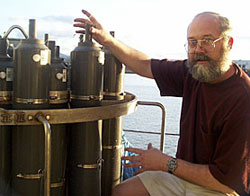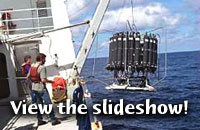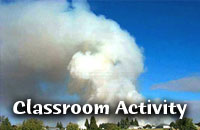|
Hot
Topics: Bob
Collier and Marvin Lilley -- The Hydrothermal Vent Prospecting Team
Hydrothermal
vents are often as big as three-story buildings. However, locating
them in the ocean can be tricky. Before scientists can even begin
studying the vents and the animals that live there, oceanographers
like Bob Collier and Marvin Lilley must find them.

Bob
Collier checks one of the water sampling bottles on the CTD frame. Collier
says that searching for vents is a lot like sniffing out a good
smell, like brownies cooking. First you catch the chocolate scent,
then you walk closer to locate the exact source -- in the oven.
But instead of using their noses to find the vents, the oceanographers explore
using a special sensor for temperature, salinity and water clarity. Specific
changes in temperature, salinity or water clarity are like the stronger chocolate
smell. These are the clues that tell the oceanographers they are coming closer
to the vents.
How do Collier and Lilley know where to begin “sniffing” for
the vents? Vents are usually located on mid-ocean ridges where
tectonic plates move apart and molten rock rises from the mantle
to create new seafloor.
“We look for heat and unique chemicals introduced by the vent into the cold,
constant background of the deep ocean. The buoyant fluids rise and spread out
as a hydrothermal plume in the ocean currents, similar to a smoke plume in the
atmosphere,” Collier says.

 They narrow the search by using specific geological data, such as detailed bathymetric
maps, seafloor rock samples, earthquake data, and information from previous hydrothermal
vent explorations.
“That will get us closer - perhaps to within a ridge segment,” says
Collier.
Next, the researchers use sensitive tools to look for chemical and physical signals
from active hydrothermal vents.
Today, one of the most useful tools for detecting hydrothermal plumes is called
a CTD sensor (Conductivity-Temperature-Depth). It acts like a toy yo-yo as it
moves up and down in the water. Since the CTD is towed behind the ship, scientists
nicknamed this technique a tow-yo.
"We lower the CTD near the seafloor and then raise and lower it using the ship’s
winch through several hundred meters of seawater while we slowly move the ship
across targets mapped by the geologists," says Collier.
The CTD«s job is to measure the salinity, temperature and
clarity of the seawater at various depths. Using the data sent
up the conducting cable that connects the CTD to the ship, scientists
map hydrothermal signals detected in the water column above the
seafloor.
Once a hydrothermal plume is detected, they send an electrical pulse down the
cable. That triggers a sample bottle on the CTD frame to collect a water sample.
When the CTD and water sample bottles are hauled back on the
ship, the researchers take the water samples and transfer them
the ship’s
laboratory. There they perform analyses to identify hydrothermal
chemicals such as iron, manganese, methane and hydrogen.
"Some of these samples tell us how close we are," Collier says. "If significant
hydrogen is detected, we are very close to a high-temperature vent. Most
of the iron from vents rapidly forms particles within the hydrothermal plume.
More dissolved iron, compared to its particulate form, tells us we are very close -- probably within a few hundred meters or less of the seafloor vent."
"That’s when things start to become exciting," Collier says.
"When we are very close, we can see buoyant fluids that are still rising ...
now it’s really time to put the cameras and ROV over the side!" At this
time geologists start mapping the site and biologists prepare to collect
samples.
"And our team can go to bed," says Collier, "until the biologists have sampled
what they need and let us come back to find the next dive target."
Back to Main Hot Topics
Page
|



